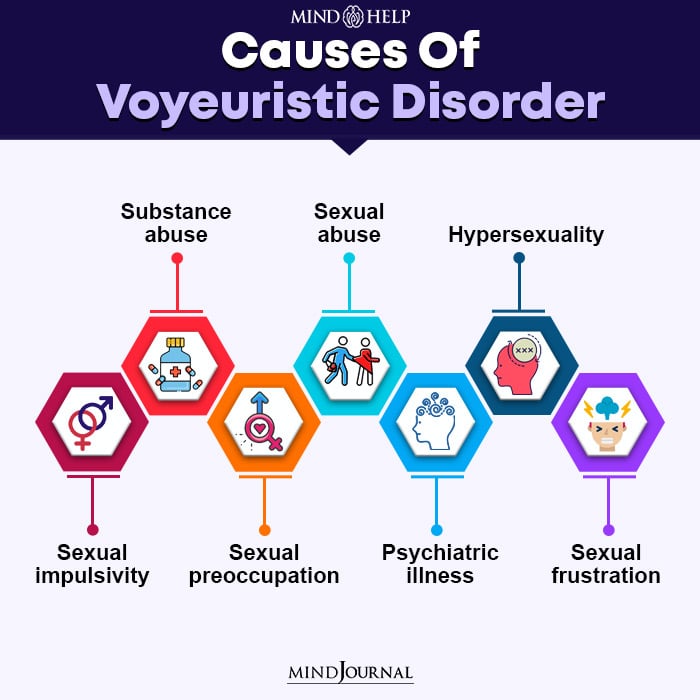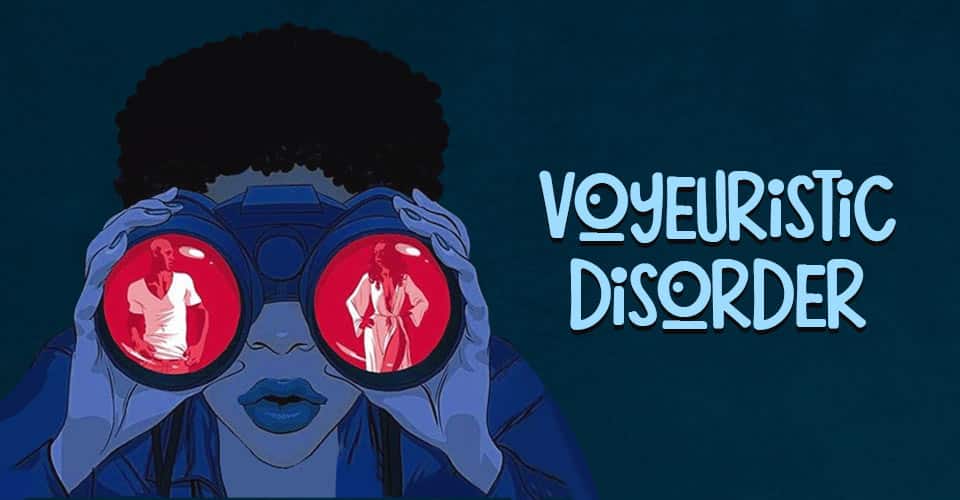Table of Contents
What makes someone aroused by secretly watching others in private moments? This intense urge may be a sign of voyeuristic disorder. Learn more about this condition below!
What Is Voyeuristic Disorder?
Voyeuristic disorder is a paraphilic disorder 1 Fisher KA, Marwaha R. Paraphilia. [Updated 2022 Mar 9]. In: StatPearls [Internet]. Treasure Island (FL): StatPearls Publishing; 2022 Jan-. Available from: https://www.ncbi.nlm.nih.gov/books/NBK554425/ , characterized by intense sexual gratification in watching or observing other people engage in sexual intercourse, undressing, or any other form of intimacy without their consent.
The Diagnostic and Statistical Manual of Mental Disorders (DSM-5) defines 2 McManus, M. A., Hargreaves, P., Rainbow, L., & Alison, L. J. (2013). Paraphilias: definition, diagnosis and treatment. F1000prime reports, 5, 36. https://doi.org/10.12703/P5-36 this disorder as “urges to observe an unsuspecting person who is naked, undressing or engaging in sexual activities or in activities deemed to be of private nature.” It usually begins in adolescence or early adulthood.
The term originates from the French word “voir,” which means “to see.” In scientific and legal contexts, this behavior is widely regarded as unethical, unlawful, and harmful. Experts emphasize that it often leads to psychological distress and violates personal boundaries, making it a serious concern in both clinical and criminal settings.
However, it is neither a disorder nor an expression of an underlying mental disorder—unless a person becomes too consumed and distressed by voyeuristic thoughts and cannot function or act normally because of his/her fantasies. According to the International Classification of Diseases (ICD-10), it is described as a “disorder of sexual preference.”
For diagnosing voyeuristic disorder, its symptoms must persist over a period of six months and the individual concerned must be over the age of 18 years. The diagnostic criteria laid down by the DSM-5 can be applied to individuals who accept or deny their paraphilic interests. But, the diagnosis 3 McManus, M. A., Hargreaves, P., Rainbow, L., & Alison, L. J. (2013). Paraphilias: definition, diagnosis and treatment. F1000prime reports, 5, 36. https://doi.org/10.12703/P5-36 of voyeuristic disorder becomes easier when the sufferers disclose their condition and report their emotional, social, or psychological impairment at the earliest.
Read More About DSM 5 Here
Understanding Voyeuristic Disorder
People suffering from the condition find sexual pleasure in observing or watching someone in an intimate moment, such as when they are naked, undressed, or engaged in sexual activities. They often go unnoticed since the receiving party is unaware that they are being observed.
The individual with this disorder experiences intense sexual gratification by observing unsuspecting and vulnerable people during their private affairs. It is worth mentioning that not everyone who has voyeuristic tendencies has a voyeuristic disorder.
This condition becomes a disorder when the urges and fantasies cause significant distress or hindrance in different areas of functioning. In such cases, it is important to learn about this condition, recognize when it becomes a problem, and understand how to overcome it responsibly without violating people’s privacy.
If you are on the receiving end of someone watching you, do not hesitate to call the police. It is not advisable to entertain the person who is ‘engaging’ with you without your consent. This behavior is also considered a criminal offense and if caught, the individual can face a prison sentence or a hefty fine.
Studies 4 Fedoroff, J. P. (2019). Voyeuristic disorder. The Paraphilias, 209-216. https://doi.org/10.1093/med/9780190466329.003.0009 find voyeuristic disorder is prevalent in 12% of males and 4% of females across the globe.
Voyeurism Vs. Voyeuristic Disorder
Voyeurism 5 Smith, R.S. Voyeurism: A review of literature. Arch Sex Behav 5, 585–608 (1976). https://doi.org/10.1007/BF01541221 refers to an intense interest in watching others engage in activities of private nature, like sexual activities. It doesn’t progress beyond sexual fantasies. For instance, someone might masturbate while watching pornography.
On the other hand, voyeurism turns into a serious voyeuristic disorder when these sexual fantasies cause significant distress to the individuals and impair their social, occupational, and other areas of functioning. It may even be distressing for others as well.
If a person gets sexually aroused by thinking or watching someone undress or have sex, they may have voyeuristic interests 6 Irányi, K., & Somogyi, E. (1980). Das Voyeur-Verhalten und dessen Modifizierung unter Alkoholeinfluss [The voyeur behavior and its modification under the influence of alcohol]. Psychiatrie, Neurologie, und medizinische Psychologie, 32(4), 199–205. .
However, these interests are problematic when they take actions that violate a person’s right to consent or privacy. It is a matter of medical concern when a person cannot control his/her voyeuristic urges.
Symptoms Of Voyeuristic Disorder
The common voyeuristic disorder symptoms are as follows:
- Persistent and intense sexual arousal from fantasizing or watching an unsuspecting person naked, disrobing, or engaging in sexual activity for at least six months
- Experiencing sexual pleasure from watching people defecate
- Eavesdropping on a highly erotic conversation
- Masturbating or having sexual fantasies while watching a person, without any interest in sexual intercourse
- Severe distress and dysfunction in social and professional lives
- Violating a person’s privacy in their home, locker room, or similar areas
- Watching people engage in sexual activity without their consent
- Entering an area illegally to watch people in their intimate moments
- Filming or photographing a person without their permission
- Feeling frustrated or stressed when one can’t engage in voyeuristic behaviors
- Inability to get sexually aroused without watching others
- Inability to resist voyeuristic activities even when its detrimental to their health and well-being
What Causes Voyeuristic Disorder?

The exact causes of voyeuristic disorder are unknown. However, this condition is associated with several risk factors that fuel behavioral and conduct disorders linked to sexual arousal or urges.
Experts, researching into voyeuristic disorder causes, believe that his disorder originates from accidentally seeing someone naked or undressed, or participating in sexual activity. This further triggers the individuals suffering from voyeuristic disorders to further participate in these activities to the point where it is not considered acceptable or ‘normal’.
Adult males with voyeuristic disorder first become aware of their sexual interests in secretly watching unsuspecting persons in their intimate moments during adolescence. However, people with voyeuristic tendencies are terrified of getting caught or admitting that they have the condition.
Other factors that contribute to voyeuristic disorder risks include:
- Substance abuse
- Sexual abuse
- Hypersexuality
Read More About Sexual Orientation Here
Responsible Behavior Related To Voyeurism
Some people with voyeuristic interests refuse to engage in behaviors that may harm someone else. Hence, they redirect their interests in other ways without violating anyone’s consent or privacy. These include:
1. Pornography
Voyeurism is a very popular genre in pornography. Adult films frequently show instances of violated privacy or uphold events from a voyeur’s point of view. Experts contend that watching pornography or consuming nude magazines and erotic literature can be one of the ways to cope with voyeuristic disorder.
2. Role-playing
If the person prefers a more hands-on action, he/she can try role-playing with consenting partners. In such cases, it is possible to set up any number of scenarios that may interest the individual, including watching from a distance or video recording. It is important to keep in mind that the individuals involved should consent to the role-playing act.
Moreover, individuals and couples can avail the services of sex-positive communities or organizations that invite people in groups or one-on-one settings to engage in sexual exploration.
3. Erotic podcasts
If the person prefers imagination over action, there are several websites from which the individual can download erotic podcasts. Erotic podcasts 7 Rojo López, A. M., Ramos Caro, M., & Espín López, L. (2021). Audio Described vs. Audiovisual Porn: Cortisol, Heart Rate and Engagement in Visually Impaired vs. Sighted Participants. Frontiers in psychology, 12, 661452. https://doi.org/10.3389/fpsyg.2021.661452 allow a person to listen to someone engaging in sexual activity or roll with the story told from the perspective of the voyeur.
Comorbid Conditions Associated With Voyeuristic Disorder
There are several comorbid conditions associated with this disorder, including:
- Exhibitionistic disorder
Read More About Attention Deficit Hyperactivity Disorder (ADHD)
Diagnosing Voyeuristic Disorder
If an individual is worried about his/her overwhelming voyeuristic behavior, it is important to seek medical attention. Voyeuristic disorder can only be diagnosed by a licensed medical or mental health professional.
The mental health professional may ask a series of questions about the patient’s sexual history, sex life, and medical history and plan the diagnosis and treatment process based on the revelations.
The DSM-5 has laid down the diagnostic criteria for voyeuristic disorder:
- Recurrent and intense sexual gratification or sexual behavior from observing unsuspecting targets when they are naked, disrobing, or engaging in sexual activity of any kind for a period of at least six months
- Exhibiting stress that leads them to seek sexual gratification from observing at least three or more unsuspecting targets when they are naked, disrobing, or engaging in sexual activity of any kind
- This condition causes clinical distress and/or social and occupational impairment
Voyeuristic disorder isn’t diagnosed in teenagers or children, as harboring a sense of curiosity and fascination about bodies and sexual activities are considered a normal aspect of growing up.
However, individuals who are above the age of 18 and appear to be exhibiting conduct disorders that violate the privacy of people around them should be diagnosed.
Voyeuristic Disorder Treatment
The first step toward recovery is identifying and acknowledging that voyeuristic tendencies may indicate an underlying psychological disorder. Paraphilic disorders often go unnoticed by the individuals themselves, as they may lack insight into the nature or consequences of their behavior. Noticing patterns of inappropriate or intrusive behavior and encouraging professional evaluation can lead to timely intervention and treatment.
The common voyeuristic disorder treatment methods include:
1. Cognitive-behavioral therapy (CBT)
CBT 8 Långström, N. The DSM Diagnostic Criteria for Exhibitionism, Voyeurism, and Frotteurism. Arch Sex Behav 39, 317–324 (2010). https://doi.org/10.1007/s10508-009-9577-4 involves the identification of negative thoughts and patterns that govern the behavior of people with mental illness. After identification, the therapist helps the patient replace those negative thoughts with positive thoughts and approaches.
The therapist may also help the patient develop impulse control by finding new ways to manage their sexual curiosity, identifying locations or situations that are triggering the voyeuristic disorder symptoms, and developing coping strategies.
Read More About Cognitive Behavioral Therapy (CBT) Here
2. Group therapy
Joining a support group can also go a long way in coping with the symptoms of voyeuristic disorder. Connecting with other people who are going through similar issues creates a space that is free of judgment and provides room for conversing about challenges and coping mechanisms.
Read More About Group Therapy Here
3. Medications
Medications may be prescribed to treat any associated comorbid conditions, such as depression or anxiety. Some studies 9 Clayton, A. H., McGarvey, E. L., Abouesh, A. I., & Pinkerton, R. C. (2001). Substitution of an SSRI with bupropion sustained release following SSRI-induced sexual dysfunction. The Journal of clinical psychiatry, 62(3), 185–190. https://doi.org/10.4088/jcp.v62n0309 found that putting patients on fluoxetine and treating their voyeuristic behavior as an obsessive/compulsive disorder showed significant results.
Another 2010 study 10 Metzl, J. (2004). From scopophilia toSurvivor: A brief history of voyeurism. Textual Practice, 18(3), 415-434. https://doi.org/10.1080/09502360410001732935 revealed that using a mixture of antidepressants and antipsychotic medications can be used to successfully treat this disorder. Some antiandrogenic drugs 11 McLeod D. G. (1993). Antiandrogenic drugs. Cancer, 71(3 Suppl), 1046–1049. https://doi.org/10.1002/1097-0142(19930201)71:3+<1046::aid-cncr2820711424>3.0.co;2-m that suppress intense sexual drive can also be used to treat patients with this condition.
4. Other methods
There is some evidence that shows that pornography can be used as a treatment. However, this is based on the idea that countries with pornography censorship have high rates of voyeurism.
Research 12 Jackson B. T. (1969). A case of voyeurism treated by counterconditioning. Behaviour research and therapy, 7(1), 133–134. https://doi.org/10.1016/0005-7967(69)90058-8 shows that voyeurs shifting the focus of their voyeuristic behaviors by looking at graphic pornography or nudes in adult magazines have been successful in addressing this disorder. In fact, consuming pornography is actually fulfilling voyeuristic desires without breaking any law.
Ways To Cope With Voyeuristic Disorder
Consider the following measures for coping with voyeuristic disorder:
- Acknowledge that you have a voyeurism-related disorder and that you need medical attention.
- Communicate with your family and friends about your disorder.
- Talk honestly with your romantic or sexual partner(s) about your sexual urges and fantasies.
- Consult with a sex therapist to explore your options for fulfilling your sexual urges and fantasies.
- Minimize the use of alcohol and other addictive substances which may increase your inappropriate urges.
- Devise self-help strategies for reducing compulsive behaviors and co-occurring mental health conditions.
- Seek social support in a community of other individuals struggling with voyeuristic disorder.
Takeaway
This disorder begins as a fairly common sexual interest, but then it becomes a concern where the individual cannot control his/her sexual desires and fantasies.
As the disorder grows severe, it begins to impact the patient’s daily life as well as make others feel uncomfortable or violated. Nonetheless, with treatment for voyeuristic disorder (using therapy and medication), it is possible to recover from this condition.
So if you are experiencing any voyeuristic disorder symptoms, it is advisable to seek professional help and timely avail treatment plans and coping strategies. This will allow you to lead a normal and healthy life, without violating or threatening anyone’s privacy.
Voyeuristic Disorder At A Glance
- Voyeuristic disorder is a paraphilic disorder in which a person gets sexually aroused by observing others during intimate moments.
- It is illegal, immoral, and undesirable behavior that violates people’s privacy.
- The condition is prevalent in people with hypersexuality, histories of sexual abuse and mental illness, etc.
- Its symptoms include sexual frustration, break-ins, obsessive consumption of pornography, etc.
- It can be easily treated with therapy and medication.
Frequently Asked Questions (FAQs)
1. What is the root cause of voyeuristic disorder?
Voyeuristic disorder does not have a fixed set of causes, but certain factors like sexual abuse, hypersexuality, substance abuse, and addiction to pornography and other erotic works increase the risks of developing the disorder.
2. What are paraphilic disorders?
Paraphilic disorders are behavioral disorders that involve intense, recurrent, and sexually arousing fantasies, urges, or conduct directed at inanimate objects, children, or nonconsenting adults.
3. Is voyeurism a mental disorder?
Voyeurism in itself is not a disorder. But, when a person becomes too consumed and distressed by voyeuristic thoughts and cannot function or act normally because of his/her fantasies, it becomes a disorder.















